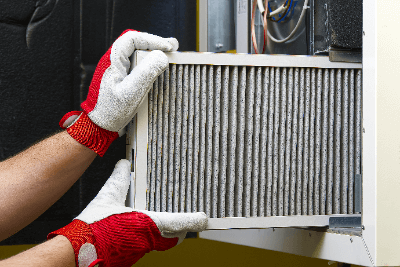What Is an Air Filter?

An air filter is a component that filters fine particles from the air. Various substances exist in the air as fine particles, called aerosols. These substances cause malfunctions and reduced productivity in industrial products. They also pose a risk of adverse health effects if inhaled into the lungs. Air filters are components that remove these contaminants.
Uses of Air Filters
Air filters are used to filter out airborne quantities. Specific applications are as follows:
1. Air Filters for Automobiles
Used to prevent airborne debris from being sucked into the interior of automobile engines.
2. Air Filters for Air Conditioning
Removes particles lurking in the air and supplies clean air. Products that remove mold and viruses are also available.
3. Clean Room
Filters are used to remove invisible dust in clean rooms where electronic devices are assembled. High performance air filters are used.
Principle of air filters
Air filters can be classified into several types according to their performance.
1. Air Filter for Coarse Dust
This filter collects particles of 5 µm or larger in diameter. The material used is non-woven chemical fiber cloth or glass fiber. The structure can be panel-shaped or other types.
2. Air Filter for Medium Performance
This filter collects particles of 1μm to 5μm in diameter. Glass fiber is used as the material. Pleated or bag-shaped filters are available.
3. Quasi-Hepa (High Efficiency Particulate Air) Filter
This filter is capable of collecting 90% to 95% or more of particles of 0.3μm in diameter. The material used is fine glass fiber.
4. Hepa (High-Efficiency Particulate Air) Filter
This filter can collect 99.97% or more of particles with a target diameter of 0.3 μm. The material used is fine glass fiber.
5. Ulpa (Ultra Low Penetration Air) Filter
This filter can collect 99.9995% or more of particles with a target diameter of 0.15μm. The material used is fine glass fiber.
Air Filter Performance
The following three indices are used to express the performance of air filters.
1. Pressure Loss
When contaminated fluid passes through a filter, resistance is generated in the fluid flow to remove the contaminant. The difference in air pressure through the filter at a given airflow rate is the “pressure drop.” It can be calculated by measuring the difference in air pressure between the inlet and outlet of the filter. Since pressure loss is also a loss of energy, it must be kept as small as possible.
2. Efficiency
Filter size is changed depending on the size of the contaminant to be removed. For example, a fine wire mesh is used for small contaminants, and a rough wire mesh is used for larger contaminants. In this way, the “efficiency” of the filter is to use different sizes and types of filters depending on the contaminant.
3. Service Life
The filtering material of an air filter deteriorates in accordance with the amount of air filtered. When a certain amount of collected dust accumulates, the filter becomes clogged. This is dangerous because if a predetermined amount of dust is collected, the pressure drop value will increase rapidly and the dust collection performance will deteriorate. High-performance filters that filter fine contaminants must be replaced periodically. This is the “life” of the filter.
Other Information on Air Filters
Difference Between Air Filters and Mist Separators
Air filters can remove foreign matter, moisture, and oil from the air. Mist separators, on the other hand, are superior to ordinary filters in removing oil.
Air filters must be installed in front of regulators to prevent foreign matter from entering solenoid valves and cylinders. In contrast, mist separators are installed between or behind regulators.
While air filters are essential to remove foreign matter, mist separators are installed according to the secondary-side equipment. For example, if a flow sensor is installed, a mist separator is essential because oil in the air can cause malfunctions.